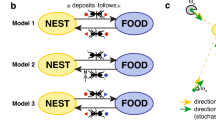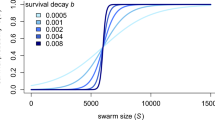Abstract
The classical macroscopic chemotaxis equations have previously been derived from an individual-based description of the tactic response of cells that use a “run-and-tumble” strategy in response to environmental cues [17,18]. Here we derive macroscopic equations for the more complex type of behavioral response characteristic of crawling cells, which detect a signal, extract directional information from a scalar concentration field, and change their motile behavior accordingly. We present several models of increasing complexity for which the derivation of population-level equations is possible, and we show how experimentally measured statistics can be obtained from the transport equation formalism. We also show that amoeboid cells that do not adapt to constant signals can still aggregate in steady gradients, but not in response to periodic waves. This is in contrast to the case of cells that use a “run-and-tumble” strategy, where adaptation is essential.
Similar content being viewed by others
References
Alt W. (1980). Biased random walk models for chemotaxis and related diffusion approximations. J. Math. Biol. 9: 147–177
Barkai N., Leibler S. (1997). Robustness in simple biochemical networks. Nature 387: 913–917
Berg H.C. (1975). How bacteria swim. Sci. Am. 233: 36–44
Berg H.C., Brown D.A. (1972). Chemotaxis in Escherichia Coli analysed by three-dimensional tracking. Nature 239(5374): 500–504
Bourret, R.B., Stock, A.M.: Molecular information processing: lessons from bacterial chemotaxis. J. Biol. Chem. 277(12), 9625–9628, Review (2002)
Chalub F., Markowich P., Perthame B., Schmeiser C. (2004). Kinetic models for chemotaxis and their drift-diffusion limits. Monatshefte für Mathematik 142(1–2): 123–141
Chung, C.Y., Funamoto, S., Firtel, R.A.: Signaling pathways controlling cell polarity and chemotaxis. Trends Biochem. Sci. 26(9), 557–566, Review (2001)
Condeelis, J., et al.: Mechanisms of ameboid chemotaxis: an evaluation of the cortical expansion model. Dev. Genet. 11, 333–340 (1990)
Dallon J. C., Othmer H.G. (1997). A discrete cell model with adaptive signalling for aggregation of Dictyostelium discoideum. Philos. Trans. R. Soc. Lond. B Biol. Sci. 352(1351): 391–417
Dallon J.C., Othmer H.G. (1998). A continuum analysis of the chemotactic signal seen by Dictyostelium discoideum. J. Theor. Biol. 194(4): 461–483
Dickinson R.B., Tranquillo R.T. (1995). Transport equations and indices for random and biased cell migration based on single cell properties. SIAM J. Appl. Math. 55(5): 1419–54
Dolak, Y., Schmeiser, Y.: Kinetic models for chemotaxis: hydrodynamic limits and spatio-temporal mechanisms. J. Math. Biol. 51(6) 595–615 (2005)
Erban, R.: From individual to collective behaviour in biological systems. Ph.D. thesis, University of Minnesota, 2005
Erban R., Hwang H. (2006). Global existence results for the complex hyperbolic models of bacterial chemotaxis. Discret. Contin. Dyn. Syst. Ser. B 6: 1239–1260
Erban R., Kevrekidis I.G., Adalsteinsson D., Elston T.C. (2006). Gene regulatory networks: a coarse-grained, equation-free approach to multiscale computation. J. Chem. Phys. 124(8): 084106
Erban, R., Kevrekidis, I.G., Othmer, H.G.: An equation-free computational approach for extracting population-level behavior from individual-based models of biological dispersal. Physica D 215, 1–24 (2006)
Erban R., Othmer H. (2004). From individual to collective behaviour in bacterial chemotaxis. SIAM J. Appl. Math. 65(2): 361–391
Erban R., Othmer H.G. (2005). From signal transduction to spatial pattern formation in E. coli: a paradigm for multi-scale modeling in biology. Multiscale Model. Simul. 3(2): 362–394
Fisher P.R., Merkl R., Gerisch G. (1989). Quantitative analysis of cell motility and chemotaxis in Dictyostelium discoideum by using an image processing system and a novel chemotaxis chamber providing stationary chemical gradients. J. Cell Biol. 108: 973–984
Ford, R., Lauffenburger, D.A.: A simple expression for quantifying bacterial chemotaxis using capillary assay data: application to the analysis of enhanced chemotactic responses from growth-limited cultures, Math. Biosci. 109(2), 127–150 (1992)
Geiger J., Wessels D., Soll D.R. (2003). Human polymorphonuclear leukocytes respond to waves of chemoattractant, like Dictyostelium. Cell Motil. Cytoskeleton 56(1): 27–44
Gerisch G. (1982). Chemotaxis in Dictyostelium. Annu. Rev. Physiol. 44: 535–552
Gerisch, G., Fromm, H., Huesgen, A., Wick, U.: Control of cell-contact sites by cyclic AMP pulses in differentiating Dictyostelium cells. Nature 255, 547–549 (1975)
Hillen T., Othmer H.G. (2000). The diffusion limit of transport equations derived from velocity-jump processes. SIAM J. Appl. Math. 61(3): 751–775
Höfer T., Maini P. (1997). Streaming instability of slime mold amoebae: an analytical model. phys. rev. e (statistical physics, plasmas, fluids and related interdisciplinary topics) 56(2): 1–7
Iijima, M., Huang, Y.E., Devreotes, P.: Temporal and spatial regulation of chemotaxis. Dev. Cell 3(4), 469–478, Review (2002)
Jin T., Zhang N., Long Y., Parent C.A., Devreotes P.N. (2000). Localization of the G protein βγ complex in living cells during chemotaxis. Science 287(5455): 1034–1036
Keller E.F., Segel L.A. (1970). Initiation of slime mold aggregation viewed as an instability. J. Theor. Biol. 26: 399–415
Kevrekidis I., Gear C., Hyman J., Kevrekidis P., Runborg O., Theodoropoulos K. (2003). Equation-free, coarse-grained multiscale computation: enabling microscopic simulators to perform system-level analysis. Commun. Math. Sci. 1(4): 715–762
Kollmann M., Lovdok L., Bartholome K., Timmer J., Sourjik V. (2005). Design principles of a bacterial signalling network. Nature 438(7067): 504–507
Koshland D.E. (1980). Bacterial chemotaxis as a model behavioral system. Raven, New York
Krishnan J., Iglesias P. (2005). A modelling framework describing the enzyme regulation of membrane lipids underlying gradient perception in Dictyostelium cells II: input–output analysis. J. Theor. Biol. 235: 504–520
Lilly, B., Dallon, J.C., Othmer, H.G.: Pattern formation in a cellular slime mold. In: Doedel, E., Tuckerman, L.S. (eds.) Numerical Methods for Bifurcation Problems and Large-Scale Dynamical Systems. IMA Proceedings, vol. 119 pp. 359–383. Springer, New York (2000)
Martiel J.L., Goldbeter A. (1987). A model based on receptor desensitization for cyclic AMP signaling in Dictyostelium cells. Biophys. J. 52: 807–828
Mato J.M., Losada A., Nanjundiah V., Konijn T.M. (1975). Signal input for a chemotactic response in the cellular slime mold Dictyostelium discoideum. Proc. Natl. Acad. Sci. 72: 4991–4993
Meinhardt H. (1999). Orientation of chemotactic cells and growth cones: models and mechanisms. J. Cell Sci. 112(Pt17): 2867–2874
Mitchison T.J., Cramer L.P. (1996). Actin-based cell motility and cell locomotion. Cell 84(3): 371–379
Othmer H.G., Dunbar S.R., Alt W. (1988). Models of dispersal in biological systems. J. Math. Biol. 26(3): 263–298
Othmer H.G., Hillen T. (2002). The diffusion limit of transport equations. Part II: chemotaxis equations. SIAM J Am 62: 1222–1260
Othmer H.G., Schaap P. (1998). Oscillatory cAMP signaling in the development of Dictyostelium discoideum. Comments on Theor. Biol. 5: 175–282
Parent, C.A., Devreotes, P.N.: A cell’s sense of direction. Science 284(5415), 765–770, Review (1999)
Pate E., Othmer H.G. (1986). Differentiation, cell sorting and proportion regulation in the slug stage of Dictyostelium discoideum. J. Theor. Biol. 118: 301–319
Patlak C.S. (1953). Random walk with persistence and external bias. Bull. Math. Biophys. 15: 311–338
Sheetz, M.P., Felsenfeld, D., Galbraith, C.G., et al.: Cell migration as a five-step cycle. Biochem. Soc. Symposia 65, 233–243 (1999)
Soll, D.R.: The use of computers in understanding how animal cells crawl. In: Jeon, K.W., Jarvik, J. (eds.) International Review of Cytology vol. 163, pp. 43–104. Academic, New York (1995)
Sperb R.P. (1979). On a mathematical model describing the aggregation of amoebae. Bull. Math. Biol. 41: 555–572
Spiro P.A., Parkinson J.S., Othmer H.G. (1997). A model of excitation and adaptation in bacterial chemotaxis. Proc. Natl. Acad. Sci. USA 94(14): 7263–7268
Swanson J., Taylor D.L. (1982). Local and spatially coordinated movements in Dictyostelium discoideum amoebae during chemotaxis. Cell 28: 225–232
Tang Y., Othmer H.G. (1995). Excitation, oscillations and wave propagation in a G-protein-based model of signal transduction in Dictyostelium discoideum. Philos. Trans. R. Soc. Lond. B Biol. Sci. 349(1328): 179–95
Tang Y., Othmer H.G. (1994). A G-protein-based model of adaptation in Dictyostelium discoideum. Math. Biosci. 120(1): 25–76
Tranquillo R.T., Lauffenburger D.A. (1987). Stochastic model for leukocyte chemosensory movement. J. Math. Biol. 25(3): 229–262
Traynor D., Milne J.L., Insall R.H., Kay R.R. (2000). Ca(2+) signalling is not required for chemotaxis in Dictyostelium. EMBO J 19(17): 4846–4854
Varnum-Finney B., Voss E., Soll D. (1987). Frequency and orientation of pseudopod formation of Dictyostelium discoideum amoebae chemotaxing in a spatial gradient: further evidence for a temporal mechanism. Cell Motil. Cytoskeleton 8(1): 18–26
Wessels D., Murray J., Soll D.R. (1992). Behavior of Dictyostelium amoebae is regulated primarily by the temporal dynamic of the natural cAMP wave. Cell Motil. Cytoskeleton 23(2): 145–156
Wessels, D.J., Zhang, H., Reynolds, J., Daniels, K., Heid, P., Lu, S., Kuspa, A., Shaulsky, G., Loomis, W.F., Soll, D.R.: The internal phosphodiesterase regA is essential for the suppression of lateral pseudopods during Dictyostelium chemotaxis. Mol. Biol. Cell 11(8), 2803–2820 (2000)
Author information
Authors and Affiliations
Corresponding author
Rights and permissions
About this article
Cite this article
Erban, R., Othmer, H.G. Taxis equations for amoeboid cells. J. Math. Biol. 54, 847–885 (2007). https://doi.org/10.1007/s00285-007-0070-1
Received:
Published:
Issue Date:
DOI: https://doi.org/10.1007/s00285-007-0070-1
Keywords
- Amoeboid cells
- Microscopic models
- Direction sensing
- Aggregation
- Chemotaxis equation
- Velocity jump process




